High-Pressure Processing Effects on Microbiological Stability, Physicochemical Properties, and Volatile Profile of a Fruit Salad
Abstract
:1. Introduction
2. Materials and Methods
2.1. Reagents and Solutions
2.2. Fruit Salad Preparation
2.3. Sample Clarification
2.4. Browning Degree
2.5. Titratable Acidity and pH
2.6. Total Soluble Solids
2.7. Total Antioxidant Capacity
2.8. Polyphenol Oxidase
2.9. Microbiological Analysis
2.10. Volatile Organic Compound Analysis
2.11. Statistical Analysis
3. Results
3.1. Microbiological Analysis
3.2. Total Soluble Solids, pH, and Titratable Acidity
3.3. Browning Degree
3.4. Total Antioxidant Capacity
3.5. Polyphenol Oxidase Activity
3.6. Volatile Organic Compounds
4. Conclusions
Supplementary Materials
Author Contributions
Funding
Institutional Review Board Statement
Informed Consent Statement
Data Availability Statement
Acknowledgments
Conflicts of Interest
References
- Balasubramaniam, V.M.; Martínez-Monteagudo, S.I.; Gupta, R. Principles and Application of High Pressure–Based Technologies in the Food Industry. Annu. Rev. Food Sci. Technol. 2015, 6, 435–462. [Google Scholar] [CrossRef]
- EFSA Panel on Biological Hazards, B. Scientific Opinion on the Risk Posed by Pathogens in Food of Non-Animal Origin. Part 2 (Salmonella in Melons). EFSA J. 2014, 12, 3831. [Google Scholar] [CrossRef]
- Candrawinata, V.I.; Golding, J.B.; Roach, P.D.; Stathopoulos, C.E. From Apple to Juice-The Fate of Polyphenolic Compounds. Food Rev. Int. 2013, 29, 276–293. [Google Scholar] [CrossRef]
- Salta, J.; Martins, A.; Santos, R.G.; Neng, N.R.; Nogueira, J.M.F.; Justino, J.; Rauter, A.P. Phenolic Composition and Antioxidant Activity of Rocha Pear and Other Pear Cultivars—A Comparative Study. J. Funct. Foods 2010, 2, 153–157. [Google Scholar] [CrossRef]
- Terefe, N.S.; Buckow, R.; Versteeg, C. Quality-Related Enzymes in Fruit and Vegetable Products: Effects of Novel Food Processing Technologies, Part 1: High-Pressure Processing. Crit. Rev. Food Sci. Nutr. 2014, 54, 24–63. [Google Scholar] [CrossRef]
- Hassoun, A.; Cropotova, J.; Trif, M.; Rusu, A.V.; Bobiş, O.; Nayik, G.A.; Jagdale, Y.D.; Saeed, F.; Afzaal, M.; Mostashari, P.; et al. Consumer Acceptance of New Food Trends Resulting from the Fourth Industrial Revolution Technologies: A NARRATIVE Review of Literature and Future Perspectives. Front. Nutr. 2022, 9, 972154. [Google Scholar] [CrossRef] [PubMed]
- Dunne, C. High Pressure Keeps Food Fresher. Available online: http://www.natick.army.mil/about/pao/05/05-22.htm (accessed on 2 October 2017).
- Misra, N.N.; Koubaa, M.; Roohinejad, S.; Juliano, P.; Alpas, H.; Inácio, R.S.; Saraiva, J.A.; Barba, F.J. Landmarks in the Historical Development of Twenty First Century Food Processing Technologies. Food Res. Int. 2017, 97, 318–339. [Google Scholar] [CrossRef] [PubMed]
- Rodriguez-Gonzalez, O.; Buckow, R.; Koutchma, T.; Balasubramaniam, V.M. Energy Requirements for Alternative Food Processing Technologies—Principles, Assumptions, and Evaluation of Efficiency. Compr. Rev. Food Sci. Food Saf. 2015, 14, 536–554. [Google Scholar] [CrossRef]
- Rao, L.; Guo, X.; Pang, X.; Tan, X.; Liao, X.; Wu, J. Enzyme Activity and Nutritional Quality of Peach (Prunus persica) Juice: Effect of High Hydrostatic Pressure. Int. J. Food Prop. 2014, 17, 1406–1417. [Google Scholar] [CrossRef]
- Hurtado, A.; Picouet, P.; Jofré, A.; Guàrdia, M.D.; Ros, J.M.; Bañon, S. Application of High Pressure Processing for Obtaining “Fresh-Like” Fruit Smoothies. Food Bioprocess Technol. 2015, 8, 2470–2482. [Google Scholar] [CrossRef]
- Keenan, D.F.; Rößle, C.; Gormley, R.; Butler, F.; Brunton, N.P. Effect of High Hydrostatic Pressure and Thermal Processing on the Nutritional Quality and Enzyme Activity of Fruit Smoothies. LWT—Food Sci. Technol. 2012, 45, 50–57. [Google Scholar] [CrossRef]
- Aaby, K.; Grimsbo, I.H.; Hovda, M.B.; Rode, T.M. Effect of High Pressure and Thermal Processing on Shelf Life and Quality of Strawberry Purée and Juice. Food Chem. 2018, 260, 115–123. [Google Scholar] [CrossRef] [PubMed]
- Zawawi, N.A.F.; Hazmi, N.A.M.; How, M.S.; Kantono, K.; Silva, F.V.M.; Sulaiman, A. Thermal, High Pressure, and Ultrasound Inactivation of Various Fruit Cultivars’ Polyphenol Oxidase: Kinetic Inactivation Models and Estimation of Treatment Energy Requirement. Appl. Sci. 2022, 12, 1864. [Google Scholar] [CrossRef]
- Roobab, U.; Abida, A.; Afzal, R.; Madni, G.M.; Zeng, X.-A.; Rahaman, A.; Aadil, R.M. Impact of High-Pressure Treatments on Enzyme Activity of Fruit-Based Beverages: An Overview. Int. J. Food Sci. Technol. 2022, 57, 801–815. [Google Scholar] [CrossRef]
- Pérez-Lamela, C.; Franco, I.; Falqué, E. Impact of High-Pressure Processing on Antioxidant Activity during Storage of Fruits and Fruit Products: A Review. Molecules 2021, 26, 5265. [Google Scholar] [CrossRef] [PubMed]
- Hurtado, A.; Guàrdia, M.D.; Picouet, P.; Jofré, A.; Ros, J.M.; Bañón, S. Stabilization of Red Fruit-Based Smoothies by High-Pressure Processing. Part II: Effects on Sensory Quality and Selected Nutrients. J. Sci. Food Agric. 2017, 97, 777–783. [Google Scholar] [CrossRef]
- Zhang, C.; Trierweiler, B.; Li, W.; Butz, P.; Xu, Y.; Rüfer, C.E.; Ma, Y.; Zhao, X. Comparison of Thermal, Ultraviolet-c, and High Pressure Treatments on Quality Parameters of Watermelon Juice. Food Chem. 2011, 126, 254–260. [Google Scholar] [CrossRef]
- Kaushik, N.; Rao, P.S.; Mishra, H.N. Comparative Analysis of Thermal-Assisted High Pressure and Thermally Processed Mango Pulp: Influence of Processing, Packaging, and Storage. Food Sci. Technol. Int. 2018, 24, 15–34. [Google Scholar] [CrossRef] [PubMed]
- El Hadi, M.A.M.; Zhang, F.J.; Wu, F.F.; Zhou, C.H.; Tao, J. Advances in Fruit Aroma Volatile Research. Molecules 2013, 18, 8200–8229. [Google Scholar] [CrossRef]
- Jiang, Y.; Song, J. Fruits and Fruit Flavor: Classification and Biological Characterization. In Handbook of Fruit and Vegetable Flavors; Hui, Y.H., Ed.; John Wiley & Sons, Inc.: New Jersey, NY, USA, 2010; pp. 3–24. ISBN 9780470227213. [Google Scholar]
- EFSA Panel on Food additives and Nutrient Sources added to Food. Scientific Opinion on the Re-Evaluation of Ascorbic Acid (E-300), Sodium Ascorbate (E-301) and Calcium Ascorbate (E-302) as Food Additives. EFSA J. 2015, 13, 4087. [Google Scholar]
- Queirós, R.P.; Santos, M.D.; Fidalgo, L.G.; Mota, M.J.; Lopes, R.P.; Inácio, R.S.; Delgadillo, I.; Saraiva, J.A. Hyperbaric Storage of Melon Juice at and above Room Temperature and Comparison with Storage at Atmospheric Pressure and Refrigeration. Food Chem. 2014, 147, 209–214. [Google Scholar] [CrossRef]
- AOAC International. AOAC International. AOAC Official Method 942.15: [Acidity (Titratable) of Food Products—Final Action]. In Official Methods of Analysis of AOAC International (12); AOAC International: Rockville, MD, USA, 1965. [Google Scholar]
- AOAC International. AOAC International. AOAC Official Method 932.12: Solids (Soluble) in Fruits and Fruit Products Refractometer Method]. In Official Methods of Analysis of AOAC International; AOAC International: Rockville, MD, USA, 1932. [Google Scholar]
- Kim, A.-N.; Lee, K.-Y.; Rahman, M.S.; Kim, H.-J.; Kerr, W.L.; Choi, S.-G. Thermal Treatment of Apple Puree under Oxygen-Free Condition: Effect on Phenolic Compounds, Ascorbic Acid, Antioxidant Activities, Color, and Enzyme Activities. Food Biosci. 2021, 39, 100802. [Google Scholar] [CrossRef]
- Juarez-Enriquez, E.; Salmeron-Ochoa, I.; Gutierrez-Mendez, N.; Ramaswamy, H.S.; Ortega-Rivas, E. Shelf Life Studies on Apple Juice Pasteurised by Ultrahigh Hydrostatic Pressure. LWT—Food Sci. Technol. 2015, 62, 915–919. [Google Scholar] [CrossRef]
- Inácio, R.S.; Barros, R.; Saraiva, J.A.; Gomes, A.M.P. Optimization of Raw Ewes’ Milk High-Pressure Pre-Treatment for Improved Production of Raw Milk Cheese. Foods 2022, 11, 435. [Google Scholar] [CrossRef]
- ISO 4833-2:2013; Microbiology of the Food Chain—Horizontal Method for the Enumeration of Microorganisms—Part 2: Colony Count at 30 °C by the Surface Plating Technique. International Organization for Standardization: Geneva, Switzerland, 2013. Available online: https://www.iso.org/standard/53728.html (accessed on 21 April 2024).
- ISO 21527-1:2008; Microbiology of Food and Animal Feeding Stuffs Horizontal Method for the Enumeration of Yeasts and Moulds—Part 1: Colony Count Technique in Products with Water Activity Greater than 0.95. International Organization for Standardization: Geneva, Switzerland, 2008. Available online: https://www.iso.org/standard/38275.html (accessed on 21 April 2024).
- Amaro, A.L.; Fundo, J.F.; Oliveira, A.; Beaulieu, J.C.; Fernández-Trujillo, J.P.; Almeida, D.P. 1-Methylcyclopropene Effects on Temporal Changes of Aroma Volatiles and Phytochemicals of Fresh-Cut Cantaloupe. J. Sci. Food Agric. 2013, 93, 828–837. [Google Scholar] [CrossRef]
- Martins, E.M.F.; Ramos, A.M.; Martins, M.L.; de Castro Leite Júnior, B.R. Fruit Salad as a New Vehicle for Probiotic Bacteria. Food Sci. Technol. 2016, 36, 540–548. [Google Scholar] [CrossRef]
- Sehrawat, R.; Kaur, B.P.; Nema, P.K.; Tewari, S.; Kumar, L. Microbial Inactivation by High Pressure Processing: Principle, Mechanism and Factors Responsible. Food Sci. Biotechnol. 2021, 30, 19–35. [Google Scholar] [CrossRef]
- Rastogi, N.K.; Raghavarao, K.S.M.S.; Balasubramaniam, V.M.; Niranjan, K.; Knorr, D. Opportunities and Challenges in High Pressure Processing of Foods. Crit. Rev. Food Sci. Nutr. 2007, 47, 69–112. [Google Scholar] [CrossRef]
- Mota, M.J.; Lopes, R.P.; Delgadillo, I.; Saraiva, J.A. Microorganisms under High Pressure—Adaptation, Growth and Biotechnological Potential. Biotechnol. Adv. 2013, 31, 1426–1434. [Google Scholar] [CrossRef]
- Chen, D.; Xi, H.; Guo, X.; Qin, Z.; Pang, X.; Hu, X.; Liao, X.; Wu, J. Comparative Study of Quality of Cloudy Pomegranate Juice Treated by High Hydrostatic Pressure and High Temperature Short Time. Innov. Food Sci. Emerg. Technol. 2013, 19, 85–94. [Google Scholar] [CrossRef]
- Varela-Santos, E.; Ochoa-Martinez, A.; Tabilo-Munizaga, G.; Reyes, J.E.; Pérez-Won, M.; Briones-Labarca, V.; Morales-Castro, J. Effect of High Hydrostatic Pressure (HHP) Processing on Physicochemical Properties, Bioactive Compounds and Shelf-Life of Pomegranate Juice. Innov. Food Sci. Emerg. Technol. 2012, 13, 13–22. [Google Scholar] [CrossRef]
- Hurtado, A.; Guàrdia, M.D.; Picouet, P.; Jofré, A.; Ros, J.M.; Bañón, S. Stabilization of Red Fruit-Based Smoothies by High-Pressure Processing. Part A. Effects on Microbial Growth, Enzyme Activity, Antioxidant Capacity and Physical Stability. J. Sci. Food Agric. 2017, 97, 770–776. [Google Scholar] [CrossRef]
- Frey-Klett, P.; Burlinson, P.; Deveau, A.; Barret, M.; Tarkka, M.; Sarniguet, A. Bacterial-Fungal Interactions: Hyphens between Agricultural, Clinical, Environmental, and Food Microbiologists. Microbiol. Mol. Biol. Rev. 2011, 75, 583–609. [Google Scholar] [CrossRef] [PubMed]
- Queirós, R.P.; Rainho, D.; Santos, M.D.; Fidalgo, L.G.; Delgadillo, I.; Saraiva, J.A. High Pressure and Thermal Pasteurization Effects on Sweet Cherry Juice Microbiological Stability and Physicochemical Properties. High Press. Res. 2015, 35, 69–77. [Google Scholar] [CrossRef]
- Landl, A.; Abadias, M.; Sárraga, C.; Viñas, I.; Picouet, P.A. Effect of High Pressure Processing on the Quality of Acidified Granny Smith Apple Purée Product. Innov. Food Sci. Emerg. Technol. 2010, 11, 557–564. [Google Scholar] [CrossRef]
- Patterson, M.F.; McKay, A.M.; Connolly, M.; Linton, M. The Effect of High Hydrostatic Pressure on the Microbiological Quality and Safety of Carrot Juice during Refrigerated Storage. Food Microbiol. 2012, 30, 205–212. [Google Scholar] [CrossRef]
- Sobral, M.M.C.; Nunes, C.; Maia, A.; Ferreira, P.; Coimbra, M.A. Conditions for Producing Long Shelf Life Fruit Salads Processed Using Mild Pasteurization. LWT—Food Sci. Technol. 2017, 85, 316–323. [Google Scholar] [CrossRef]
- Wolbang, C.M.; Fitos, J.L.; Treby, M.T. The Effect of High Pressure Processing on Nutritional Value and Quality Attributes of Cucumis melo L. Innov. Food Sci. Emerg. Technol. 2008, 9, 196–200. [Google Scholar] [CrossRef]
- Jacobo-Velázquez, D.; Hernández-Brenes, C. Biochemical Changes during the Storage of High Hydrostatic Pressure Processed Avocado Paste. J. Food Sci. 2010, 75, S264–S270. [Google Scholar] [CrossRef]
- Zhang, L.; Dai, S.; Brannan, R.G. Effect of High Pressure Processing, Browning Treatments, and Refrigerated Storage on Sensory Analysis, Color, and Polyphenol Oxidase Activity in Pawpaw (Asimina triloba L.) Pulp. LWT 2017, 86, 49–54. [Google Scholar] [CrossRef]
- Guerrero-Beltrán, J.A.; Swanson, B.G.; Barbosa-Cánovas, G.V. Shelf Life of HHP-Processed Peach Puree With Antibrowning Agents. J. Food Qual. 2005, 28, 479–491. [Google Scholar] [CrossRef]
- Fundo, J.F.; Miller, F.A.; Garcia, E.; Santos, J.R.; Silva, C.L.M.; Brandão, T.R.S. Physicochemical Characteristics, Bioactive Compounds and Antioxidant Activity in Juice, Pulp, Peel and Seeds of Cantaloupe Melon. J. Food Meas. Charact. 2018, 12, 292–300. [Google Scholar] [CrossRef]
- Rúa, J.; López-Rodríguez, I.; Sanz, J.; García-Fernández, M.C.; del Valle, M.P.; García-Armesto, M.R. Improving Functional Properties of “Piel de Sapo” Melon Juice by Addition of a Lippia citriodora Natural Extract and Probiotic-Type Lactic Acid Bacteria. LWT 2018, 96, 75–81. [Google Scholar] [CrossRef]
- Mukhopadhyay, S.; Sokorai, K.; Ukuku, D.; Fan, X.; Juneja, V. Effect of High Hydrostatic Pressure Processing on the Background Microbial Loads and Quality of Cantaloupe Puree. Food Res. Int. 2017, 91, 55–62. [Google Scholar] [CrossRef] [PubMed]
- Denoya, G.I.; Polenta, G.A.; Apóstolo, N.M.; Budde, C.O.; Sancho, A.M.; Vaudagna, S.R. Optimization of High Hydrostatic Pressure Processing for the Preservation of Minimally Processed Peach Pieces. Innov. Food Sci. Emerg. Technol. 2016, 33, 84–93. [Google Scholar] [CrossRef]
- Morales-de la Peña, M.; Salinas-Roca, B.; Escobedo-Avellaneda, Z.; Martín-Belloso, O.; Welti-Chanes, J. Effect of High Hydrostatic Pressure and Temperature on Enzymatic Activity and Quality Attributes in Mango Puree Varieties (cv. Tommy Atkins and Manila). Food Bioprocess Technol. 2018, 11, 1211–1221. [Google Scholar] [CrossRef]
- Falguera, V.; Gatius, F.; Ibarz, A.; Barbosa-Cánovas, G.V. Kinetic and Multivariate Analysis of Polyphenol Oxidase Inactivation by High Pressure and Temperature Processing in Apple Juices Made from Six Different Varieties. Food Bioprocess Technol. 2013, 6, 2342–2352. [Google Scholar] [CrossRef]
- Amaro, A.L.; Beaulieu, J.C.; Grimm, C.C.; Stein, R.E.; Almeida, D.P.F. Effect of Oxygen on Aroma Volatiles and Quality of Fresh-Cut Cantaloupe and Honeydew Melons. Food Chem. 2012, 130, 49–57. [Google Scholar] [CrossRef]
- Oh, S.H.; Lim, B.S.; Hong, S.J.; Lee, S.K. Aroma Volatile Changes of Netted Muskmelon (Cucumis melo L.) Fruit during Developmental Stages. Hortic. Environ. Biotechnol. 2011, 52, 590–595. [Google Scholar] [CrossRef]
- Chen, Y.; Yin, H.; Wu, X.; Shi, X.; Qi, K.; Zhang, S. Comparative Analysis of the Volatile Organic Compounds in Mature Fruits of 12 Occidental Pear (Pyrus communis L.) Cultivars. Sci. Hortic. 2018, 240, 239–248. [Google Scholar] [CrossRef]
- Taiti, C.; Marone, E.; Lanza, M.; Azzarello, E.; Masi, E.; Pandolfi, C.; Giordani, E.; Mancuso, S. Nashi or Williams Pear Fruits? Use of Volatile Organic Compounds, Physicochemical Parameters, and Sensory Evaluation to Understand the Consumer’s Preference. Eur. Food Res. Technol. 2017, 243, 1917–1931. [Google Scholar] [CrossRef]
- Lomelí-Martín, A.; Martínez, L.M.; Welti-Chanes, J.; Escobedo-Avellaneda, Z. Induced Changes in Aroma Compounds of Foods Treated with High Hydrostatic Pressure: A Review. Foods 2021, 10, 878. [Google Scholar] [CrossRef] [PubMed]
- Navarro, M.; Verret, C.; Pardon, P.; Moueffak, A. Changes in Volatile Aromatic Compounds of Strawberry Puree Treated by High-Pressure During Storage. Int. J. High Press. Res. 2002, 22, 693–696. [Google Scholar] [CrossRef]
- Rodrigo, D.; Jolie, R.; Loey, A.V.; Hendrickx, M. Thermal and High Pressure Stability of Tomato Lipoxygenase and Hydroperoxide Lyase. J. Food Eng. 2007, 79, 423–429. [Google Scholar] [CrossRef]
- Kebede, B.; Lee, P.Y.; Leong, S.Y.; Kethireddy, V.; Ma, Q.; Aganovic, K.; Eyres, G.T.; Hamid, N.; Oey, I. A Chemometrics Approach Comparing Volatile Changes during the Shelf Life of Apple Juice Processed by Pulsed Electric Fields, High Pressure and Thermal Pasteurization. Foods 2018, 7, 169. [Google Scholar] [CrossRef] [PubMed]
- Vincenti, S.; Mariani, M.; Alberti, J.-C.; Jacopini, S.; Brunini-Bronzini de Caraffa, V.; Berti, L.; Maury, J. Biocatalytic Synthesis of Natural Green Leaf Volatiles Using the Lipoxygenase Metabolic Pathway. Catalysts 2019, 9, 873. [Google Scholar] [CrossRef]
- Yi, J.; Kebede, B.; Kristiani, K.; Buvé, C.; Van Loey, A.; Grauwet, T.; Hendrickx, M. The Potential of Kiwifruit Puree as a Clean Label Ingredient to Stabilize High Pressure Pasteurized Cloudy Apple Juice during Storage. Food Chem. 2018, 255, 197–208. [Google Scholar] [CrossRef]
- Vervoort, L.; Grauwet, T.; Njoroge, D.M.; Van Der Plancken, I.; Matser, A.; Hendrickx, M.; Van Loey, A. Comparing Thermal and High Pressure Processing of Carrots at Different Processing Intensities by Headspace Fingerprinting. Innov. Food Sci. Emerg. Technol. 2013, 18, 31–42. [Google Scholar] [CrossRef]
- Fernández-Trujillo, J.; Dos-Santos, N.; Martínez-Alcaraz, R.; Le Bleis, I. Non-Destructive Assessment of Aroma Volatiles from a Climacteric Near-Isogenic Line of Melon Obtained by Headspace Stir-Bar Sorptive Extraction. Foods 2013, 2, 401–414. [Google Scholar] [CrossRef]
- Goliáš, J.; Kožíšková, J.; Létal, J. Changes in Volatiles during Cold Storage and Subsequent Shelf-Life of “conference” Pears Treated with 1-MCP. Acta Hortic. 2015, 1079, 465–471. [Google Scholar] [CrossRef]
- Giannetti, V.; Boccacci Mariani, M.; Mannino, P.; Marini, F. Volatile Fraction Analysis by HS-SPME/GC-MS and Chemometric Modeling for Traceability of Apples Cultivated in the Northeast Italy. Food Control 2017, 78, 215–221. [Google Scholar] [CrossRef]
- Reis, S.F.A.R.; Rocha, S.M.; Barros, A.S.; Delgadillo, I.; Coimbra, M.A. Establishment of the Volatile Profile of “Bravo de Esmolfe” Apple Variety and Identification of Varietal Markers. Food Chem. 2009, 113, 513–521. [Google Scholar] [CrossRef]
- Chaparro-Torres, L.A.; Bueso, M.C.; Fernández-Trujillo, J.P. Aroma Volatiles Obtained at Harvest by HS-SPME/GC-MS and INDEX/MS-E-Nose Fingerprint Discriminate Climacteric Behaviour in Melon Fruit. J. Sci. Food Agric. 2016, 96, 2352–2365. [Google Scholar] [CrossRef] [PubMed]
- Obando-Ulloa, J.M.; Moreno, E.; García-Mas, J.; Nicolai, B.; Lammertyn, J.; Monforte, A.J.; Fernández-Trujillo, J.P. Climacteric or Non-Climacteric Behavior in Melon Fruit. 1. Aroma Volatiles. Postharvest Biol. Technol. 2008, 49, 27–37. [Google Scholar] [CrossRef]
- Lee, J.; Jang, H.W.; Jeong, M.C.; Yoo, S.R.; Ha, J. Analysis of Volatile Compounds as Quality Indicators for Fuji Apples after Cold Storage. J. Food Biochem. 2017, 41, 1–11. [Google Scholar] [CrossRef]
- Yi, X.K.; Liu, G.F.; Rana, M.M.; Zhu, L.W.; Jiang, S.L.; Huang, Y.F.; Lu, W.M.; Wei, S. Volatile Profiling of Two Pear Genotypes with Different Potential for White Pear Aroma Improvement. Sci. Hortic. 2016, 209, 221–228. [Google Scholar] [CrossRef]
- Fredes, A.; Sales, C.; Barreda, M.; Valcárcel, M.; Roselló, S.; Beltrán, J. Quantification of Prominent Volatile Compounds Responsible for Muskmelon and Watermelon Aroma by Purge and Trap Extraction Followed by Gas Chromatography-Mass Spectrometry Determination. Food Chem. 2016, 190, 689–700. [Google Scholar] [CrossRef]
- Engel, K.; Heidlas, J.; Tressl, R. The Flavour of Tropical Fruits (Banana, Melon, Pineapple). In Food Flavours. Part C. The Flavour of Fruits; Morton, I.D., Macleod, A.J., Eds.; Elsevier B.V.: Amsterdam, The Netherlands, 1990; pp. 201–206. ISBN 0-444-87362-7. [Google Scholar]
- Paillard, N.M.M. The Flavour of Apples, Pears and Quinces. In Food Flavours. Part C. The Flavour of Fruits; Morton, I.D., Macleod, A.J., Eds.; Elsevier B.V.: Amsterdam, The Netherlands, 1990; pp. 1–34. ISBN 0-444-87362-7. [Google Scholar]
- Fernández-Trujillo, J.; Zarid, M.; Bueso, M.C. Methodology to Remove Strong Outliers of Non-Climacteric Melon Fruit Aroma at Harvest Obtained by HS-SPME GC-MS Analysis. Separations 2018, 5, 30. [Google Scholar] [CrossRef]
- Burdock, G.A. Fenaroli’s Handbook of Flavor Ingredients, 4th ed.; CRC Press LLC: Boca Raton, FL, USA, 2002; ISBN 0-8493-0946-8. [Google Scholar]
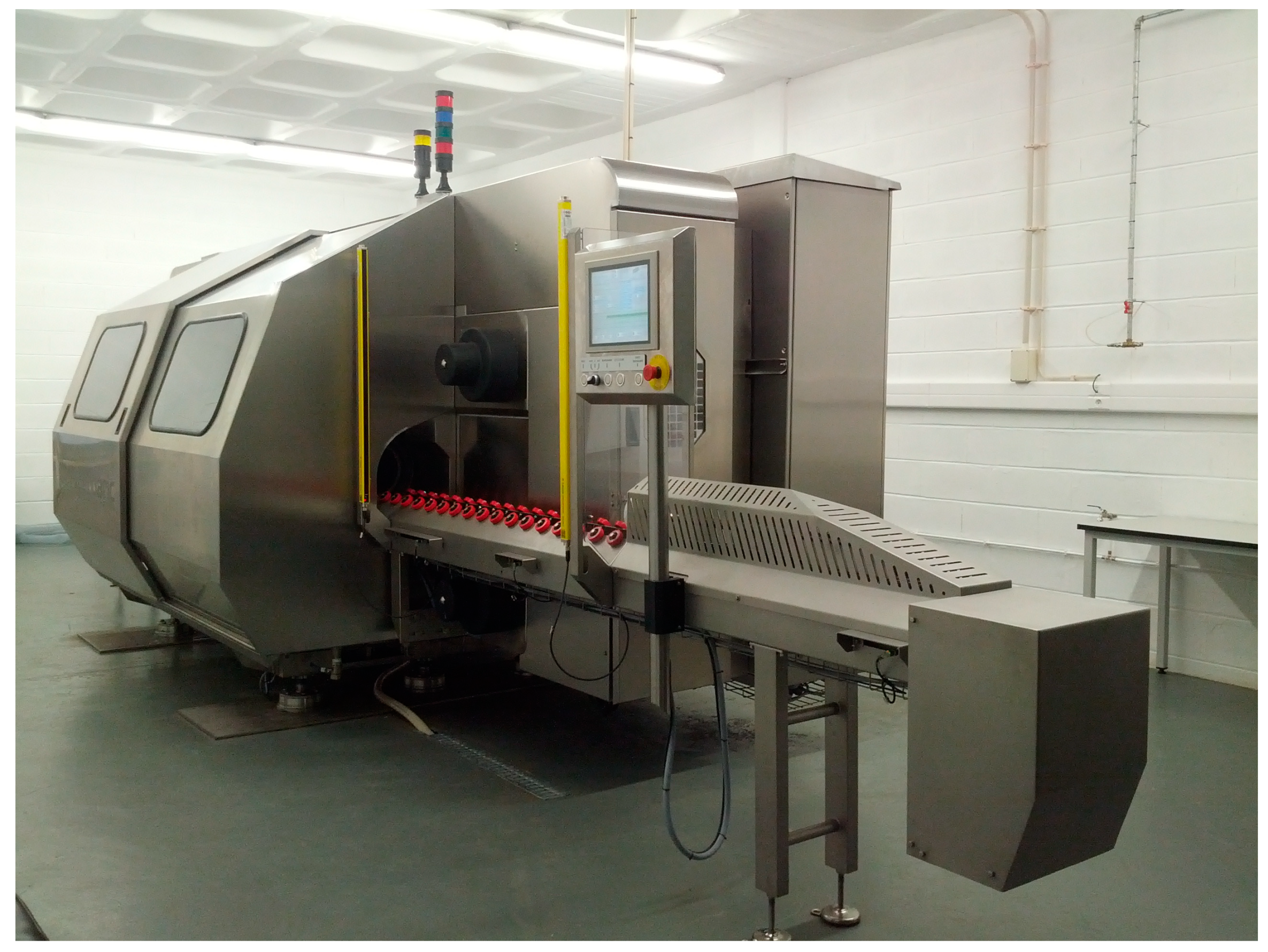

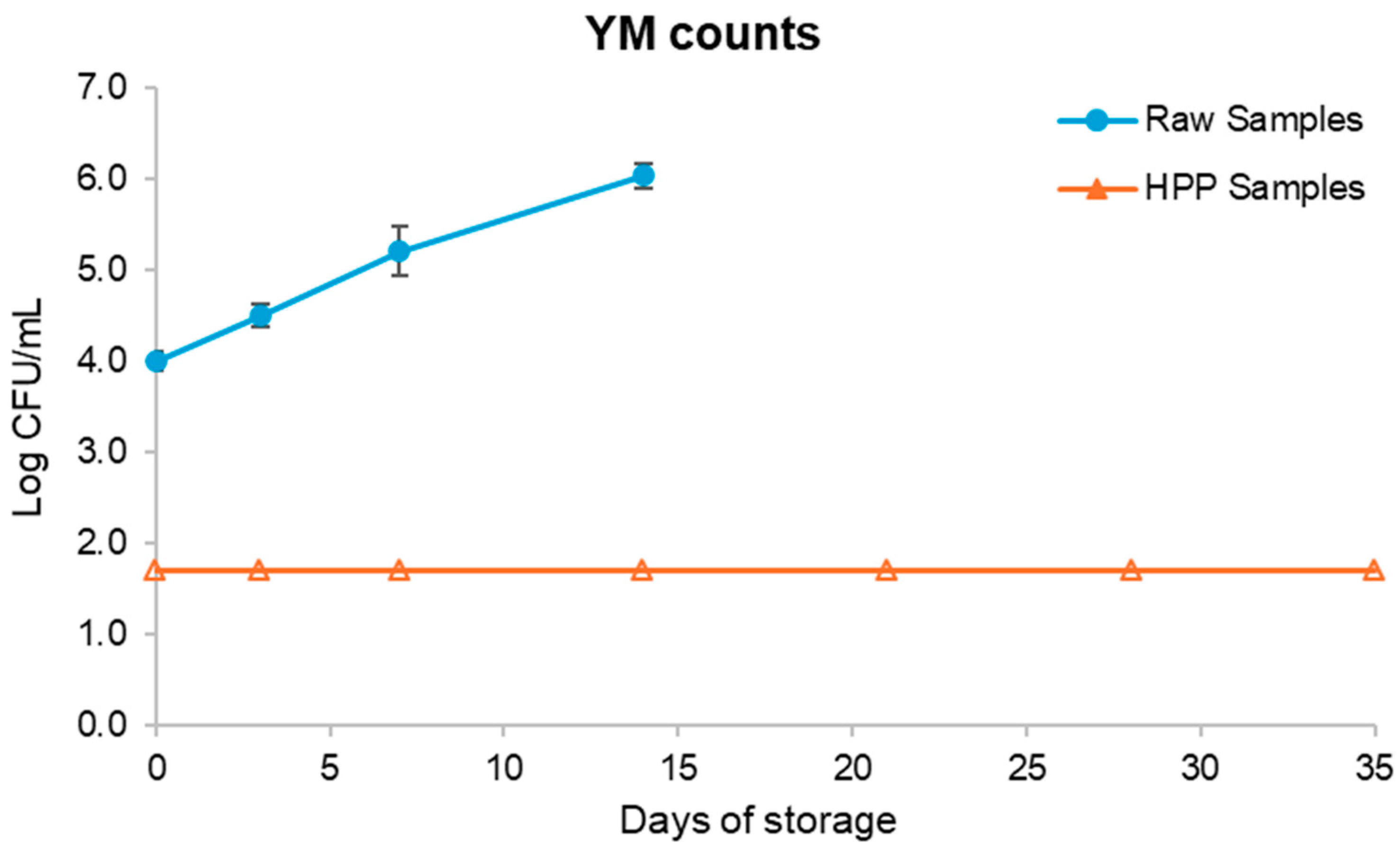
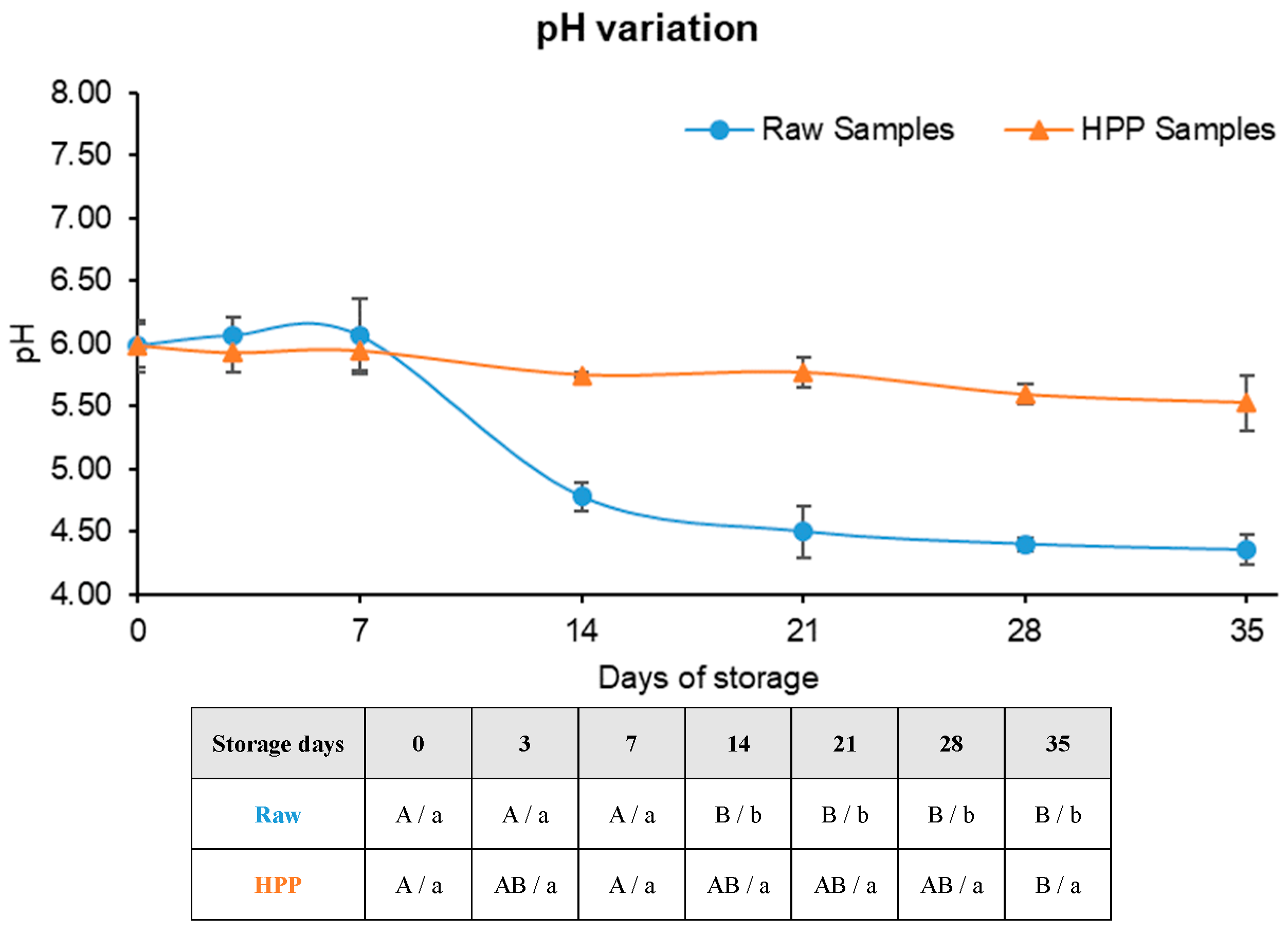
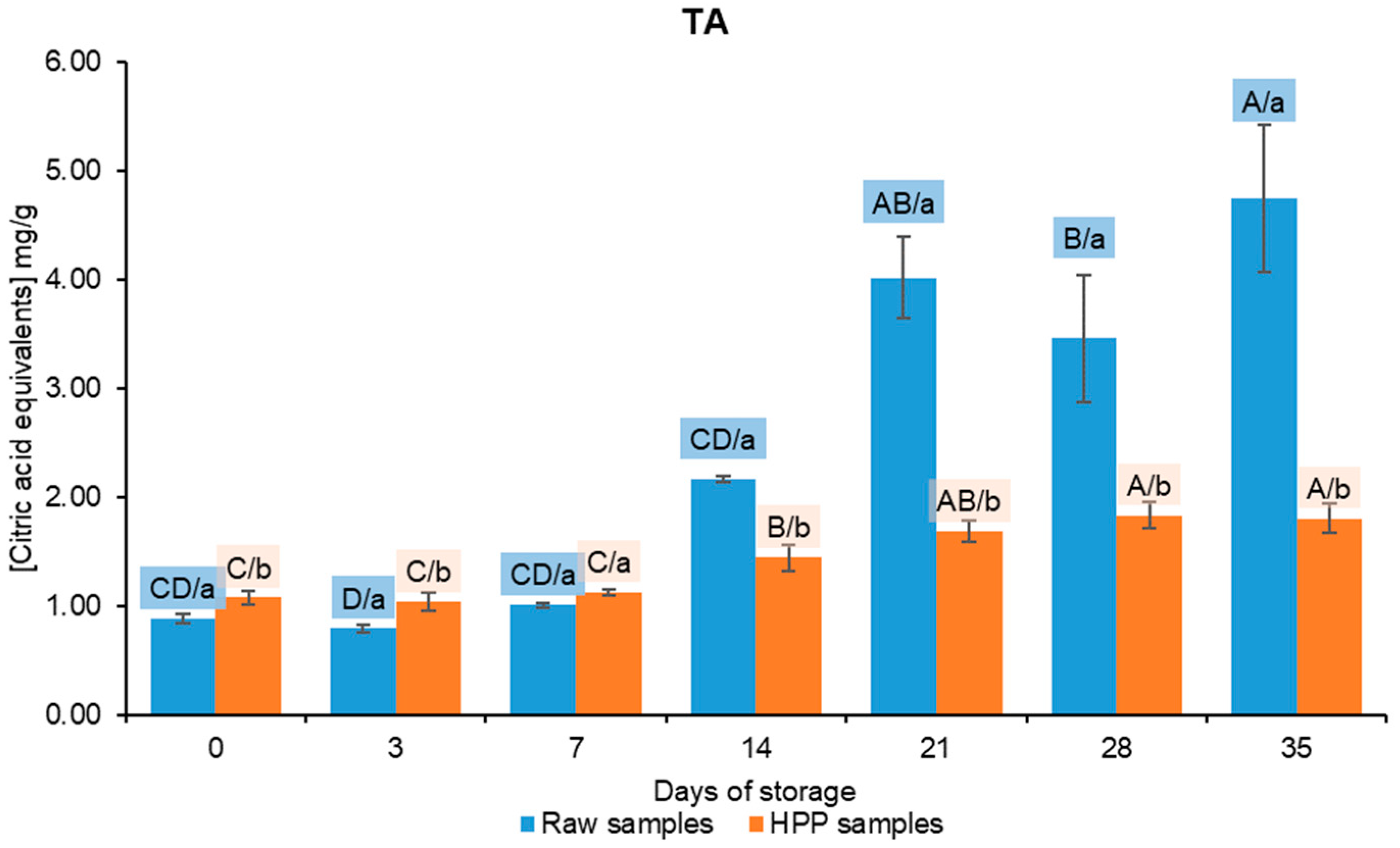
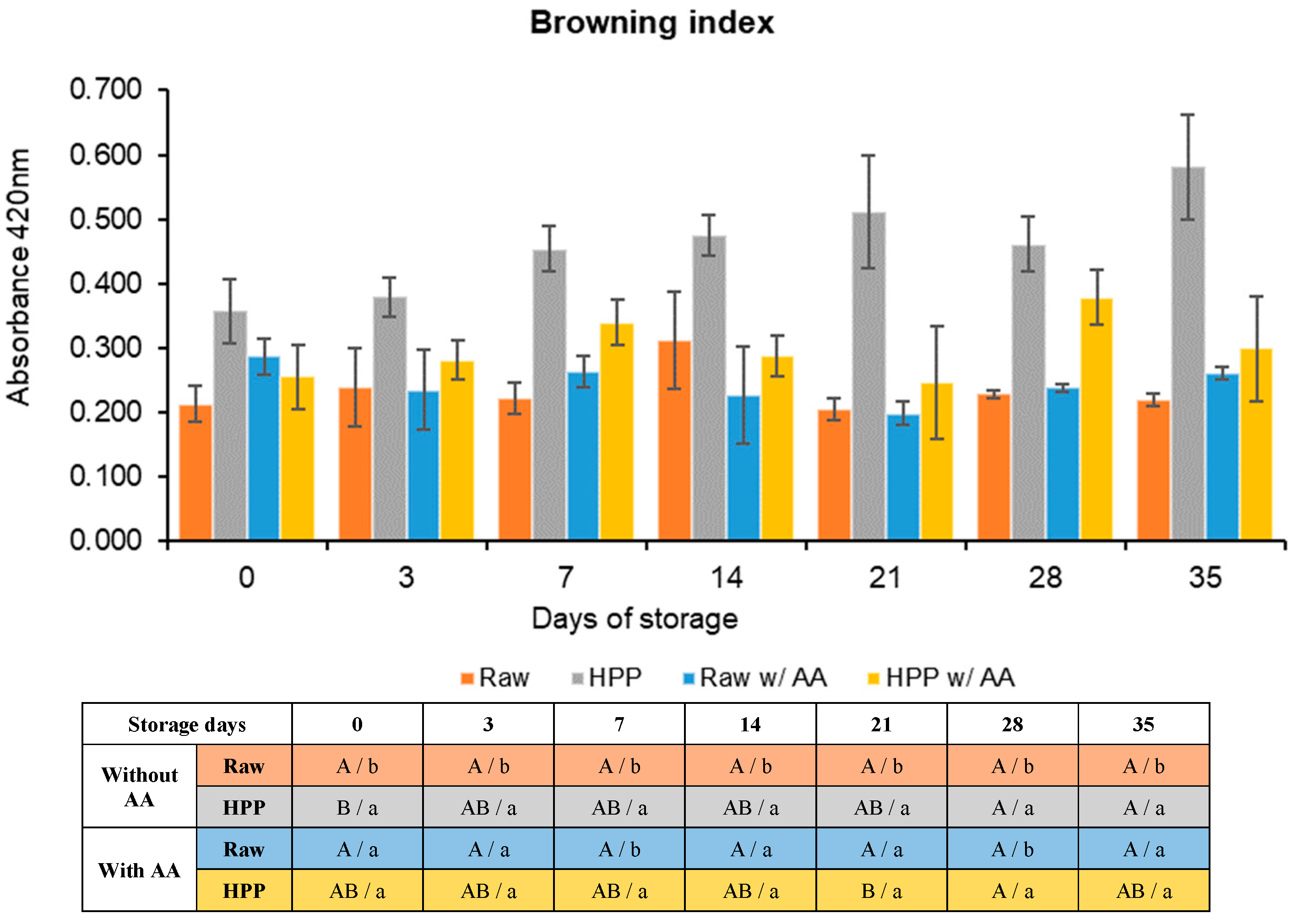
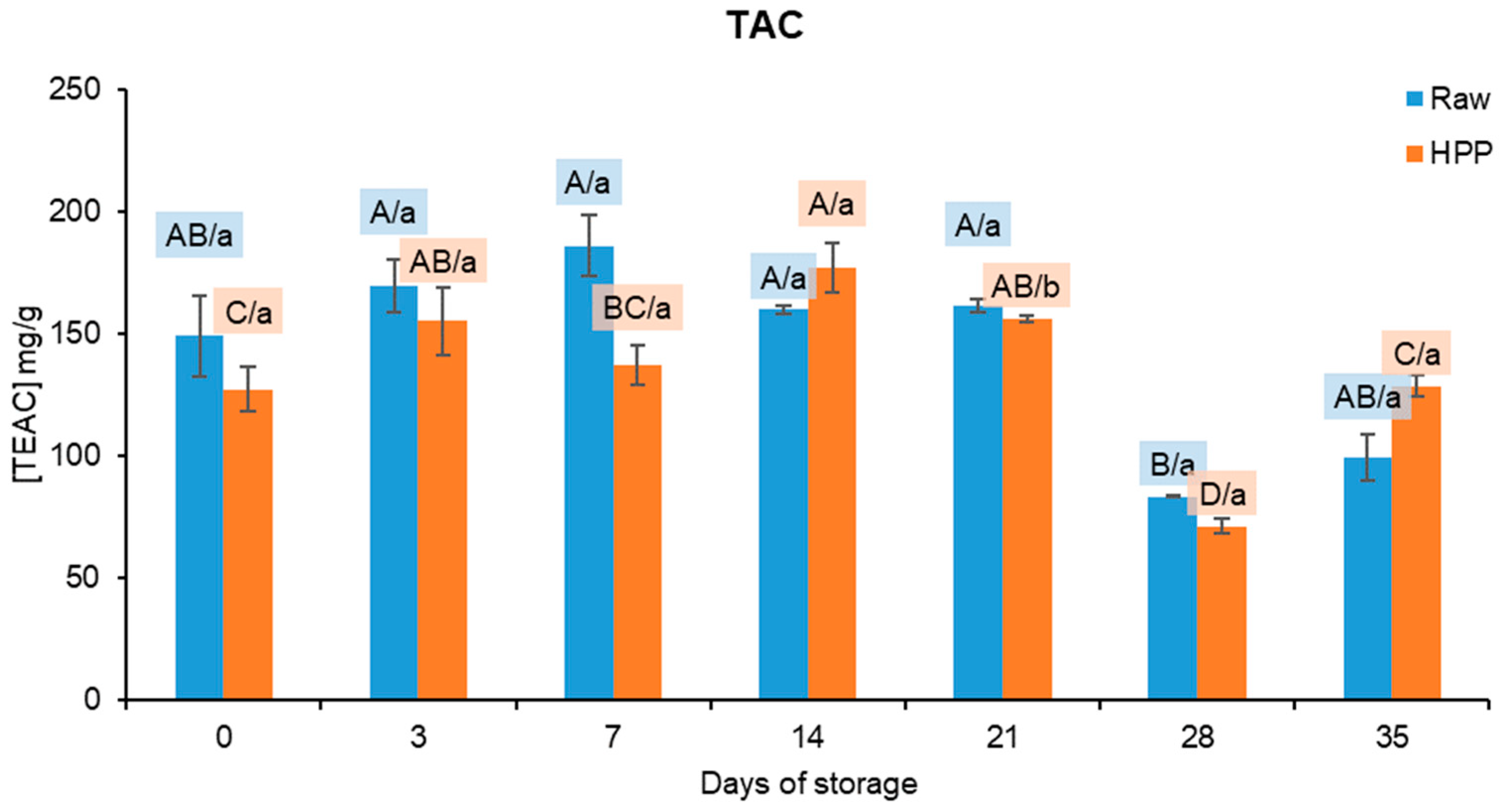


| Compound Relative Percentage (%) | ||||||||||||
|---|---|---|---|---|---|---|---|---|---|---|---|---|
| Raw Samples Stored at 4 °C | HPP Samples Stored at 4 °C | |||||||||||
| Compound Family | RT a | Compound Name | CAS N° | RI b | Day 0 | 3rd Day | 7th Day | Day 0 | 3rd Day | 7th Day | 14th Day | 21st Day |
| Acetate esters | 1.72–1.88 | Ethyl acetate | 141-78-6 | 612 | 3.47 ± 0.66 A/b | 2.74 ± 1.48 A/b | 3.29 ± 0.28 A/a | 8.04 ± 1.67 A/a | 7.35 ± 0.99 A/a | 4.80 ± 1.56 A/a | 5.17 ± 0.50 A | 5.13 ± 3.9 A |
| 2.88/2.98 | Propyl acetate | 109-60-4 | 708 | 0.42 ± 0.06 A | 0.54 ± 0.01 A/a | 0.52 ± 0.11 A/b | nd | 0.56 ± 0.40 A/a | 0.79 ± 0.04 A/a | 0.30 ± 0.11 A | nd | |
| 5.4-5.6 | Butyl acetate | 123-86-4 | 812 | 15.7 ± 0.44 A/b | 14.2 ± 2.2 A/b | 8.35 ± 1.75 B/b | 19.7 ± 0.6 AB/a | 21.5 ± 0.1 A/a | 21.5 ± 0.1 A/a | 13.4 ± 3.3 BC | 11.2 ± 2.4 C | |
| 7.9–8.05 | 2-methyl-1-butanol acetate | 624-41-9 | 880 | 0.24 ± 0.01 A/b | 0.13 ± 0.02 B/a | 0.11 ± 0.06 B/a | 1.76 ± 0.45 A/a | 0.18 ± 0.05 B/a | 0.15 ± 0.07 B/a | 0.02 ± 0.01 B | nd | |
| 9.4–9.6 | Pentyl acetate | 628-63-7 | 911 | 0.68 ± 0.05 B/a | 1.20 ± 0.13 AB/a | 1.77 ± 0.42 A/a | 0.69 ± 0.22 A/a | 0.46 ± 0.14 AB/b | 0.49 ± 0.10 AB/b | 0.26 ± 0.06 B | 0.23 ± 0.07 B | |
| 14.2 | Hexyl acetate | 142-92-7 | 1011 | 8.41 ± 2.32 A/a | 6.85 ± 0.86 A/a | 6.37 ± 1.12 A/a | 5.02 ± 2.53 A/a | 3.85 ± 0.78 AB/b | 3.85 ± 0.78 AB/a | 1.11 ± 0.11 B | 0.64 ± 0.15 AB | |
| 14.32–14.35 | 2-hexen-1-ol acetate | 2497-18-9 | 1016 | 0.17 ± 0.09 B/a | 0.39 ± 0.07 A/a | 0.31 ± 0.03 AB/a | 0.27 ± 0.04 A/a | 0.10 ± 0.05 B/b | 0.10 ± 0.05 B/b | nd | nd | |
| 17.96 | Heptyl acetate | 112-06-1 | 1113 | 0.15 ± 0.01 C/b | 0.49 ± 0.03 B | 0.83 ± 0.11 A | 0.21 ± 0.01 a | nd | nd | nd | nd | |
| 20.42 | 6-nonenyl acetate | 35854-86-5 | 1308 | 0.24 ± 0.03 A/b | 0.23 ± 0.04 A/a | 0.22 ± 0.02 A/a | 0.62 ± 0.04 A/a | 0.26 ± 0.03 B/a | 0.26 ± 0.02 B/a | 0.16 ± 0.02 C | 0.10 ± 0.01 C | |
| 20.44 | Nonyl acetate | 143-13-5 | 1308 | 0.10 ± 0.01 A | 0.12 ± 0.02 A | 0.14 ± 0.02 A | nd | nd | nd | nd | 0.03 ± 0.00 | |
| S acetate esters | 29.3 ± 1.5 A/b | 26.52 ± 3.2 AB/b | 21.71 ± 3.5 B/b | 36.45 ± 2.4 A/a | 34.3 ± 0.7 A/a | 31.8 ± 1.4 A/a | 20.0 ± 2.8 B | 17.3 ± 5.4 B | ||||
| Non-acetate esters | 19.73 | Hexyl 2-methylbutyrate | 10032-15-2 | 1236 | 0.02 ± 0.01 B/a | 0.03 ± 0.01 AB/a | 0.05 ± 0.02 A/a | 0.03 ± 0.02 B/a | 0.06 ± 0.03 AB/a | 0.13 ± 0.05 A/a | 0.01 ± 0.00 B | 0.03 ± 0.01 B |
| Aldehydes | 4.6–5.08 | Hexanal | 66-25-1 | 800 | 9.46 ± 0.26 A/b | 2.28 ± 0.47 B/b | 2.79 ± 0.69 B/b | 12.3 ± 1.3 A/a | 9.88 ± 1.68 A/a | 8.40 ± 1.27 A/a | 8.82 ± 2.42 A | 10.5 ± 3.9 A |
| 6.7–6.95 | (E)-2-hexenal | 6728-26-3 | 854 | 4.66 ± 0.21 A/a | 2.18 ± 0.60 B/a | 1.38 ± 0.16 B/a | 2.18 ± 0.29 A/b | 1.42 ± 0.08 B/a | 1.34 ± 0.21 B/a | 1.07 ± 0.26 B | 1.61 ± 0.42 AB | |
| 8.66–8.92 | Heptanal | 111-71-7 | 901 | 0.40 ± 0.02 C/b | 1.40 ± 0.19 B/a | 2.44 ± 0.29 A/a | 0.78 ± 0.03 B/a | 0.81 ± 0.13 B/b | 1.09 ± 0.14 AB/b | 1.26 ± 0.16 A | 1.03 ± 0.13 AB | |
| 11.25–11.45 | 2-heptenal | 18829-55-5 | 958 | 0.51 ± 0.05 B/a | 0.64 ± 0.02 A/a | 0.62 ± 0.03 A/a | 0.60 ± 0.07 B/a | 0.79 ± 0.11 B/a | 0.71 ± 0.13 B/a | 1.67 ± 0.09 A | 1.65 ± 0.15 A | |
| 13.55 | Octenal | 124-13-0 | 1003 | 0.39 ± 0.05 A/b | 0.43 ± 0.10 A/a | 0.44 ± 0.07 A/a | 0.57 ± 0.04 A/a | 0.48 ± 0.12 A/a | 0.47 ± 0.10 A/a | 0.36 ± 0.06 A | 0.43 ± 0.13 A | |
| 16.2 | 2-octenal | 2548-87-0 | 1060 | 0.10 ± 0.01 B/b | 0.12 ± 0.02 AB/b | 0.13 ± 0.01 A/a | 0.18 ± 0.02 B/a | 0.23 ± 0.07 AB/a | 0.27 ± 0.12 AB/a | 0.39 ± 0.00 A | 0.37 ± 0.03 A | |
| 17.71 | (Z)-6-nonenal | 2277-19-2 | 1101 | 10.7 ± 1.1 B/a | 13.8 ± 0.6 A/a | 9.74 ± 0.12 B/a | 6.74 ± 0.17 A/b | 4.93 ± 0.58 B/b | 4.44 ± 0.41 BC/b | 3.84 ± 0.72 BC | 3.25 ± 0.05 C | |
| 17.74 | Nonanal | 124-19-6 | 1104 | 7.04 ± 0.42 A/a | 6.47 ± 0.40 AB/a | 5.53 ± 0.38 B/a | 7.53 ± 0.39 A/a | 5.95 ± 1.23 AB/a | 5.15 ± 1.01 B/a | 3.94 ± 0.44 B | 4.26 ± 0.71 B | |
| 18.62–18.68 | (E,Z)-2,6-nonadienal | 557-48-2 | 1155 | 11.8 ± 1.7 A/a | 12.9 ± 1.1 A/a | 10.9 ± 0.7 A/a | 5.71 ± 0.46 B/b | 7.25 ± 0.57 B/b | 6.69 ± 0.74 B/b | 13.9 ± 0.7 A | 13.1 ± 0.9 A | |
| 18.7–18.8 | (E)-2-nonenal | 18829-56-6 | 1162 | 9.67 ± 0.40 A/a | 11.0 ± 2.1 A/a | 10.5 ± 0.4 A/a | 5.58 ± 0.59 BC/b | 7.19 ± 0.19 ABC/b | 4.42 ± 6.99 B/a | 14.4 ± 0.4 A | 14.0 ± 1.4 AB | |
| 19.37 | Decanal | 112-31-2 | 1206 | 0.58 ± 0.13 A/b | 0.52 ± 0.06 A/b | 0.62 ± 0.12 A/b | 0.99 ± 0.12 A/a | 1.01 ± 0.13 A/a | 1.29 ± 0.36 A/a | 0.66 ± 0.21 A | 0.67 ± 0.07 A | |
| 19.46 | (E,E)-2,4-nonadienal | 5910-87-2 | 1213 | 0.09 ± 0.01 B/b | 0.13 ± 0.02 A/a | 0.14 ± 0.01 A/a | 0.13 ± 0.03 C/a | 0.16 ± 0.04 C/a | 0.20 ± 0.09 BC/a | 0.31 ± 0.02 AB | 0.40 ± 0.01 A | |
| S aldehydes | 55.4 ± 2.9 A/a | 51.8 ± 4.2 AB/a | 45.2 ± 0.9 B/a | 43.3 ± 2.8 AB/b | 39.9 ± 3.94 AB/b | 34.5 ± 5.97 B/b | 50.6 ± 3.2 A | 51.3 ± 6.8 A | ||||
| Alcohols | 7.47–7.65 | 1-hexanol | 111-27-3 | 868 | 1.57 ± 0.06 B/a | 2.00 ± 0.06 B/a | 3.70 ± 0.51 A/a | 1.44 ± 0.13 A/a | 1.37 ± 0.48 A/a | 1.41 ± 0.40 A/b | 1.63 ± 0.33 A | 1.38 ± 0.15 A |
| 12.07 | 1-heptanol | 111-70-6 | 970 | 0.03 ± 0.01 A/b | 0.31 ± 0.02 A/a | 1.25 ± 0.24 B/a | 0.11 ± 0.03 A/a | 0.09 ± 0.01 A/b | 0.07 ± 0.02 A/b | 0.08 ± 0.01 A | 0.08 ± 0.05 A | |
| 12.49 | 1-octen-3-ol | 3391-86-4 | 980 | 0.04 ± 0.00 C/b | 0.07 ± 0.01 B/b | 0.12 ± 0.02 A/a | 0.14 ± 0.01 B/a | 0.15 ± 0.01 B/a | 0.16 ± 0.02 B/a | 0.35 ± 0.06 A | 0.28 ± 0.04 A | |
| 14.86 | 2-ethyl-1-hexanol | 104-76-7 | 1030 | 0.14 ± 0.03 A/a | 0.07 ± 0.01 B/b | 0.13 ± 0.02 A/b | 0.20 ± 0.07 B/a | 0.54 ± 0.01 B/a | 0.47 ± 0.11 B/a | 0.18 ± 0.03B | 1.11 ± 0.25 A | |
| 16.84 | 1-octanol | 111-87-5 | 1071 | 0.24 ± 0.04 B/b | 0.30 ± 0.05 B/a | 0.47 ± 0.04 A/a | 0.42 ± 0.02 A/a | 0.39 ± 0.05 A/b | 0.33 ± 0.06 A/b | 0.45 ± 0.02 A | 0.41 ± 0.13 A | |
| 18.6 | (Z)-3-nonen-1-ol | 10340-23-5 | 1143 | nd | nd | 0.48 ± 0.02 | 0.05 ± 0.00 A | 0.06 ± 0.01 A | nd | nd | nd | |
| 18.85 | (E,Z)-2,6-nonadien-1-ol | 7786-44-9 | 1169 | 0.24 ± 0.01 B/a | 0.24 ± 0.03 B/a | 0.66 ± 0.09 A/a | 0.18 ± 0.02 A/b | 0.14 ± 0.02 A/b | 0.14 ± 0.03 A/b | 0.14 ± 0.03 A | 0.16 ± 0.05 A | |
| 18.89 | (E)-2-nonen-1-ol | 31502-14-4 | 1176 | 0.37 ± 0.01 B | 0.35 ± 0.06 B | 0.64 ± 0.09 A | nd | nd | nd | nd | nd | |
| 18.92–18.96 | 1-nonanol | 28473-21-4 | 1173 | 2.17 ± 0.09 C/b | 4.09 ± 0.20 B/a | 8.67 ± 1.01 A/a | 5.45 ± 0.31 A/a | 3.39 ± 0.74 B/a | 3.27 ± 0.53 B/b | 3.16 ± 0.55 B | 2.57 ± 0.06 B | |
| S alcohols | 4.8 ± 0.2 C/b | 7.4 ± 0.3 B/a | 16.1 ± 1.8 A/a | 7.98 ± 0.47 A/a | 6.12 ± 0.39 AB/b | 5.81 ± 0.32 B/b | 5.99 ± 0.84 B | 5.99 ± 0.22 AB | ||||
| Furans | 12.98 | 2-pentyl-furan | 3777-69-3 | 993 | 0.32 ± 0.03 C/b | 0.67 ± 0.04 B/a | 0.85 ± 0.02 A/b | 0.63 ± 0.05 C/a | 1.28 ± 0.45 BC/a | 2.63 ± 0.21 A/a | 2.39 ± 0.23 A | 2.21 ± 0.58 AB |
| 13.45 | cis-2-pentenylfuran | 70424-13-4 | 1002 | 0.07 ± 0.01 C/b | 0.18 ± 0.01 B/a | 0.22 ± 0.02 A/b | 0.17 ± 0.03 B/a | 0.31 ± 0.13 B/a | 0.79 ± 0.16 A/a | 1.11 ± 0.11 A | 1.10 ± 0.17 A | |
| S furans | 0.39 ± 0.04 C/b | 0.85 ± 0.05 B/a | 1.07 ± 0.04 A/b | 0.80 ± 0.07 B/a | 1.59 ± 0.58 B/a | 3.43 ± 0.03 A/a | 3.51 ± 0.26 A | 3.32 ± 0.76 A | ||||
| Terpenes | 10.08 | α-pinene | 80-56-8 | 937 | 0.09 ± 0.02 B/b | 0.12 ± 0.01 B/b | 0.20 ± 0.03 A/a | 0.25 ± 0.05 A/a | 0.32 ± 0.06 A/a | 0.25 ± 0.06 A/a | 0.15 ± 0.07 A | 0.27 ± 0.11 A |
| 14.6 | Limonene | 5989-54-8 | 1030 | 1.81 ± 2.65 A/a | 2.87 ± 4.11 A/a | 0.75 ± 0.52 A/a | 2.25 ± 3.58 A/a | 4.27 ± 0.33 A/a | 2.18 ± 2.02 A/a | 0.87 ± 0.57 A | 2.06 ± 3.11 A | |
| 21.94 | α-farnesene | 502-61-4 | 1508 | 0.13 ± 0.01 B/a | 0.14 ± 0.04 B/b | 0.24 ± 0.03 A/a | 0.11 ± 0.09 B/a | 0.31 ± 0.07 AB/a | 0.38 ± 0.11 A/a | 0.21 ± 0.03 AB | 0.32 ± 0.14 AB | |
| S terpenes | 2.03 ± 2.65 A/a | 3.12 ± 4.09 A/a | 1.19 ± 0.50 A/a | 2.61 ± 3.59 A/a | 4.89 ± 0.19 A/a | 2.81 ± 1.97 A/a | 1.23 ± 0.65 A | 2.65 ± 3.09 A | ||||
Disclaimer/Publisher’s Note: The statements, opinions and data contained in all publications are solely those of the individual author(s) and contributor(s) and not of MDPI and/or the editor(s). MDPI and/or the editor(s) disclaim responsibility for any injury to people or property resulting from any ideas, methods, instructions or products referred to in the content. |
© 2024 by the authors. Licensee MDPI, Basel, Switzerland. This article is an open access article distributed under the terms and conditions of the Creative Commons Attribution (CC BY) license (https://creativecommons.org/licenses/by/4.0/).
Share and Cite
Lopes, A.C.; Queirós, R.P.; Inácio, R.S.; Pinto, C.A.; Casal, S.; Delgadillo, I.; Saraiva, J.A. High-Pressure Processing Effects on Microbiological Stability, Physicochemical Properties, and Volatile Profile of a Fruit Salad. Foods 2024, 13, 1304. https://doi.org/10.3390/foods13091304
Lopes AC, Queirós RP, Inácio RS, Pinto CA, Casal S, Delgadillo I, Saraiva JA. High-Pressure Processing Effects on Microbiological Stability, Physicochemical Properties, and Volatile Profile of a Fruit Salad. Foods. 2024; 13(9):1304. https://doi.org/10.3390/foods13091304
Chicago/Turabian StyleLopes, Ana C., Rui P. Queirós, Rita S. Inácio, Carlos A. Pinto, Susana Casal, Ivonne Delgadillo, and Jorge A. Saraiva. 2024. "High-Pressure Processing Effects on Microbiological Stability, Physicochemical Properties, and Volatile Profile of a Fruit Salad" Foods 13, no. 9: 1304. https://doi.org/10.3390/foods13091304








